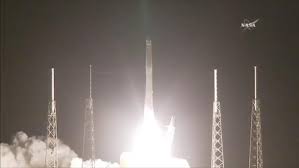
A towering new rocket has taken flight, carrying what could be the first commercial lander to touch down on the moon — and the first lunar landing mission to launch from the United States since 1972.
The Vulcan Centaur rocket, a never-before-flown model developed by United Launch Alliance, a joint venture by Boeing and Lockheed Martin, roared to life at Cape Canaveral Space Force Station in Florida at 2:18 a.m. ET Monday. The launch vehicle is blaring toward space, expending its fuel as it attempts to rip away from Earth’s gravity and send the lunar lander, called Peregrine, tucked inside on its way to the moon.
At around 3 a.m. ET, the Peregrine spacecraft is expected to separate from the rocket and begin its slow journey to the lunar surface. If all goes according to plan, the lander could touch down on the moon on February 23.
What’s on board
Pittsburgh-based company Astrobotic Technology developed the Peregrine lander — named after the falcon that is the fastest-flying bird in the world — under a contract with NASA.
The space agency paid Astrobotic $108 million to develop Peregrine and fly NASA’s science experiments to the lunar surface.
But the space agency is just one customer among many for this mission.
Of the 20 payloads that Peregrine will carry to the moon, five are NASA science instruments. The other 15 come from a range of customers.
Some are additional science payloads from nations such as Mexico, while others include a robotics experiment from a private UK-based company and trinkets or mementos that the German shipping company DHL put together.
Peregrine is also carrying human remains on behalf of two commercial space burial companies — Elysium Space and Celestis — a move that’s sparked opposition from Navajo Nation, the largest group of Native Americans in the United States. The group contends that allowing the remains to touch down on the lunar surface would be an affront to many Indigenous cultures, which regard the moon as sacred. Celestis offers to carry ashes to the moon for prices starting at more than $10,000, according to the company’s website.
The five NASA-sponsored experiments include two instruments to monitor the radiation environment, “helping us better prepare to send crewed missions back to the moon,” said Paul Niles, NASA’s project scientist for the Commercial Lunar Payload Services program, the arm of NASA that provided funding for Peregrine, during a Thursday news briefing. Other instruments will analyze the makeup of the lunar soil, looking for water and hydroxyl molecules. NASA will also study the moon’s super-thin atmosphere.
Once on the moon’s surface, Peregrine is expected to operate for up to 10 days before its landing site is plunged into darkness — making it too cold to go on.
Also on board the Vulcan Centaur rocket, packed separately from the Peregrine lander, is another payload from the space burial company Celestis.
The object, on a mission dubbed the Enterprise Flight, contains 265 capsules with human remains as well as DNA samples from former US presidents John F. Kennedy, George Washington and Dwight Eisenhower.
The remains also include “the creator and several cast members of the original Star Trek television series, as well as an Apollo-era astronaut, together with people from all walks of life, interests, and vocations,” according to the company’s website.
The Apollo astronaut whose remains are aboard the Enterprise Flight is Philip Chapman, who was selected for the astronaut corps in 1967 but never flew to space. He died in 2021.
A new rocket
The excitement of an impending lunar landing attempt aside, the launch of ULA’s Vulcan Centaur rocket was an event in its own right.
The rocket is one of the most highly anticipated new vehicles to take flight in years. If the rocket’s mission is successful, it could be a game-changer for ULA and the broader launch industry.
ULA was formed in 2006 in response to the US military’s need to keep both Boeing’s Delta and Lockheed Martin’s Atlas rockets operational. But the launch industry looks far different today than it did nearly two decades ago, and in the meantime SpaceX has emerged as a dominant force that undercuts ULA on price.
ULA and its CEO, Tory Bruno, envision Vulcan Centaur will replace its Atlas and Delta rockets. Vulcan Centaur already has about 70 missions lined up, according to Bruno.
ULA has a pristine launch record with practically no failed missions. Vulcan Centaur builds on the success of ULA’s Atlas rockets by using essentially the same upper stage — the portion of the rocket that powers a spacecraft to orbital speeds after the initial liftoff.
But a major change was made to the rocket’s first stage, the bottom portion that gives it the initial burst of power off the launchpad.
Vulcan Centaur was propelled by two side boosters as well as two US-made rocket engines — which the Jeff Bezos-funded company Blue Origin developed — at the base of its first-stage booster, replacing Russian-made engines that powered the Atlas rockets. ULA’s reliance on Russian engines became politically unpopular as tensions between the United States and Russia have grown in recent years.
Vulcan Centaur’s debut was already years overdue, though it’s common in the aerospace industry for companies to blow past deadlines.
ULA encountered lengthy delays awaiting Blue Origin’s new engines. And a Vulcan Centaur upper stage was inadvertently destroyed on a test stand last year.
Despite those setbacks, Bruno said in November that development of Vulcan Centaur has been one of the “more orderly and well-executed development programs that I’ve worked on in my very long career in the aerospace industry.”
In the moments after liftoff, the rocket appeared to be operating as intended.


 Crypto News Land
Crypto News Land ETHNews
ETHNews CFN
CFN U_Today
U_Today Thecoinrepublic.com
Thecoinrepublic.com DogeHome
DogeHome Optimisus
Optimisus Optimisus
Optimisus DeFi Planet
DeFi Planet






















